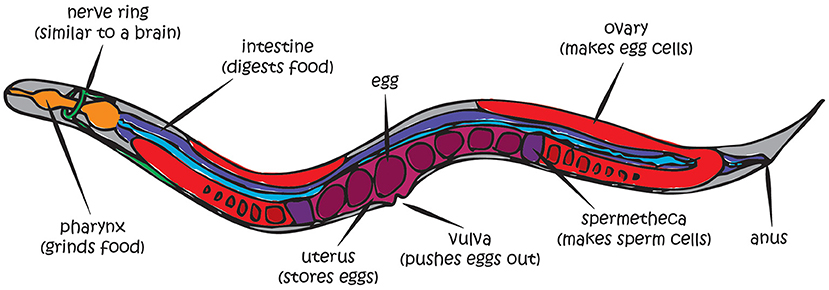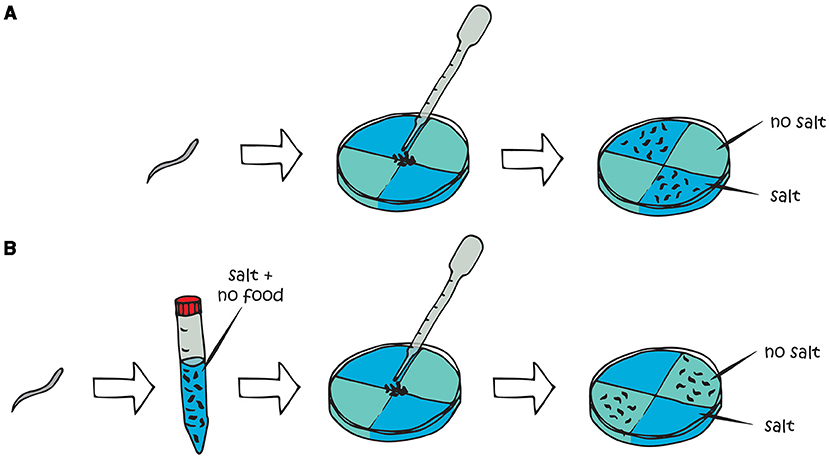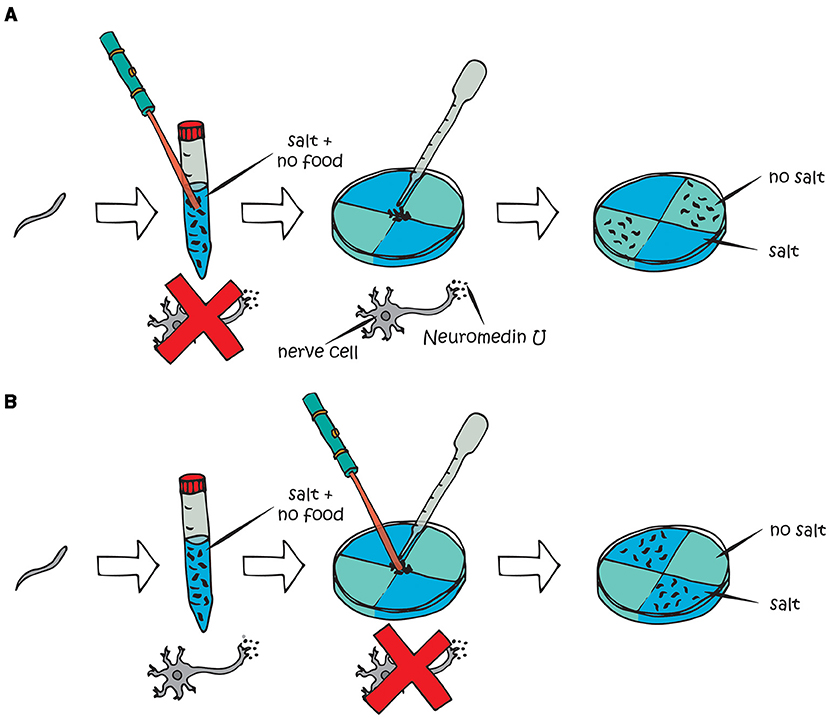Abstract
The human brain is the most complicated system in biology, and there is still much to be discovered about how it works. How are we able to learn new things and remember what we learned? How come some children have learning difficulties, and many people start to lose their memory when they get older? Research on humans is hard, and so scientists instead look for help from an unexpected partner—the tiny worm C. elegans. Just like us, these small creatures have a nervous system, the body’s super-fast messaging network that helps you think, feel and move. They are even able to learn! In this article, we will introduce you to this wonderful worm and its learning behavior to show you how much it can teach us about learning.
The Celebrity Worm C. elegans
Meet C. elegans—or Caenorhabditis elegans if you want to sound extra smart—a worm that has led to dozens of important scientific discoveries and won four Nobel Prizes. Barely the size of a grain of sand, you might already have come across C. elegans on a compost heap or in a rotting apple without even noticing it. Because they are so small, they are easy to keep in large numbers in scientific laboratories. Scientists use a microscope to see the worms close up. The worm has a simple body, long and curved like a snake (Figure 1). As it is see-through, its dark intestine and round eggs are visible as well. This transparency is pretty useful for scientists, as they can see what is going on inside the worm’s body without having to cut it open. Most of the worms are hermaphrodites, meaning they are male and female at the same time. For that reason, a single worm can have 300 offspring in a few days’ time, without the help of any other worms. These advantages make it an ideal animal to use for all kinds of research [1].

- Figure 1 - The simple body plan of C. elegans.
When we are specifically interested in understanding how the nervous system works, C. elegans has some other great benefits. Every hermaphrodite worm has exactly 302 nerve cells. Each of those cells has a unique name, and we often know what it is important for. For example, the AWC nerve cell in the head senses smells, and the PLM cell in the tail feels gentle touch. Scientists even created a map showing how all these cells are connected, the so-called connectome, making C. elegans the first animal for which this was achieved so completely [2]. We know a lot about the hundreds of small molecules that are used as messengers in the nervous system as well. Worms also display a lot of behaviors that are easy to observe, measure, and compare. This way, neuroscientists can easily study how they move and mate, which tastes and smells they prefer, how much they eat and poop, and how well they reproduce. And of course, how well they learn.
Worms Can Learn
You might think that such a tiny creature could not do something as complicated as learning. But you would be wrong! Despite only having 302 nerve cells, compared to the 86 billion in your human brain (that is ten times the number of humans on Earth), this tiny worm can learn new things. It also has a memory to store that information. In the laboratory, scientists have done several kinds of experiments to show that worms can learn and remember, and we will explain one of them here.
Perhaps you have heard of Pavlov’s dog. In a famous experiment, the Russian scientist Pavlov always let his dog hear a ticking sound before giving it food. He noticed that, after a while, the dog started to drool when it heard the ticking, before it saw or smelt the food. Even if the dog did not get any food at all, it would still drool whenever it heard a tick. That is because it had learned the simple rule “ticking sound = food”. We can do a similar test using C. elegans. This worm’s favorite food is slimy bacteria, which tastes a little salty. Because of that, C. elegans likes the taste of salt because it usually means there is food in the neighborhood. If you put some worms on a round laboratory plate in which two quarters contain salt and two do not, they will crawl to the salty quarters (Figure 2A). Now for the learning experiment. This time, the worms are first kept in a tube with salt but without any food. If you then put them on a similar laboratory plate, they will crawl to the non-salty quarters instead of the salty ones (Figure 2B)! That is because they have learned that “salt = no food”, and so they will avoid it, as nobody likes feeling hungry [3].

- Figure 2 - C. elegans learning experiment.
- (A) C. elegans worms usually like the taste of salt, as they have learned to link it to tasty bacteria. If you put them in the middle of an experimental plate with two salty (dark) and two non-salty (light) quarters, they will move toward the salt. (B) If you first put the worms in a tube with salt but without food, they will learn to link saltiness to lack of food. If you then place them on that same experimental plate, they will now move to the non-salty quarters.
We Can Learn from Worms
You might be wondering why we should care whether these microscopic creatures can or cannot learn. The reason is that by studying how C. elegans learns, we can also discover more about how we humans learn. Although we may look pretty different from worms, there are a surprising number of similarities between us. We share at least 40% of our DNA—the genetic code that makes us what we are, our recipe book if you will—with this worm. We also have similar organs and cells, such as muscles, a nervous system, and an intestine. Even the way nerve cells communicate with each other is alike, using the same tiny molecules. Thanks to all of this, discoveries we make about how the worm learns new things could possibly tell us something about how we learn as well. Not only can C. elegans give us more insight into our own body and mind, but it could also, in the long term, help us understand and treat problems such as learning disorders or memory loss.
An Example of What We Learned
So, what does an experiment using worms to study learning look like, and what has it taught us? In one example, our research team was interested in a small molecule called neuromedin U, or NMU, that you can find in areas of the brain that play an important part in learning. NMU can send signals between nerve cells. It is released by one nerve cell and can be detected by a receiver, the so-called NMU receptor, on another nerve cell to pass on a signal. We created worms missing either the NMU or NMU receptor genes. These worms could no longer send signals using this small molecule. Then, we did the salt learning test described earlier. The worms missing either NMU or the NMU receptor could no longer properly learn “salt = no food”, so many of them continued moving toward the salt, instead of moving away from it [4]. This proved that NMU and its receptor play an important role in normal learning behavior—if a worm is missing either of them, they are no longer fully able to learn!
We then created worms in which nerve cells give off light in the dark. We did this for the cells that make NMU or the NMU receptor. As C. elegans is transparent, this allowed us to spot the nerve cells in which these molecules can be found in the worm. Using nifty technology that can switch nerve cells on and off using light, we turned off the nerve cells from which NMU is sent out. This means we stopped NMU from being sent out by shining a laser at these worms. We did so either while the worms were learning (in the tube with salt and without food, Figure 3A) or when they were remembering what they learned (on the plate with salty and non-salty quarters, Figure 3B). The first worms could still learn “salt = no food”, while the second worms could not remember this. This means NMU does not play a role during the learning process itself, but instead when worms are recalling those memories of what they learned [4].

- Figure 3 - Technique using light to turn off the NMU-releasing nerve cells.
- (A) If you turn these nerve cells off during the learning stage, C. elegans can still learn “salt = no food”. (B) If you turn the nerve cells off during the remembering stage, C. elegans can no longer remember “salt = no food”. This means worms need NMU to recall what they have previously learned.
Humans also have NMU and NMU receptors in their nervous systems and other body parts. These molecules are known to be involved in all kinds of behaviors, such as how much you eat and how you deal with stress. You can also find them specifically in the parts of the brain that are involved in learning. Their role in learning and memory has not been unraveled yet, but as NMU plays such an important role in learning in C. elegans, it may also do so in humans. After all, in the famous words of the German philosopher Friedrich Nietzsche: “You have evolved from worm to man, but much within you is still worm”.
Glossary
Caenorhabditis Elegans (C. Elegans): ↑ A small roundworm commonly used in research.
Hermaphrodite: ↑ An organism that has both male and female reproductive organs.
Connectome: ↑ The map of connections between all nerve cells.
Neuromedin U (NMU): ↑ A signaling molecule in the nervous system that helps cells communicate.
NMU Receptor: ↑ A receiver molecule that can bind neuromedin U to pass on a signal.
Conflict of Interest
The authors declare that the research was conducted in the absence of any commercial or financial relationships that could be construed as a potential conflict of interest.
Acknowledgments
The authors are funded by ERC grant 950328 (FLEXPEPNET) KU Leuven Research Council grant C16/19/003, and Baillet Latour Fund.
References
[1] ↑ Corsi, A. K., Wightman, B., and Chalfie, M. 2015. A Transparent window into biology: a primer on Caenorhabditis elegans. WormBook 18:1–31. doi: 10.1895/wormbook.1.177.1
[2] ↑ Cook, S. J., Jarrell, T. A., Brittin, C. A., Wang, Y., Bloniarz, A. E., Yakovlev, M. A., et al. 2019. Whole-animal connectomes of both Caenorhabditis elegans sexes. Nature 571:63–71. doi: 10.1038/s41586-019-1352-7
[3] ↑ Saeki, S., Yamamoto, M., Iino, Y. 2001. Plasticity of chemotaxis revealed by paired presentation of a chemoattractant and starvation in the nematode Caenorhabditis elegans. J. Exp. Biol. 204:1757–64. doi: 10.1242/jeb.204.10.1757
[4] ↑ Watteyne, J., Peymen, K., Van der Auwera, P., Borghgraef, C., Vandewyer, E., et al. 2020. Neuromedin U signaling regulates retrieval of learned salt avoidance in a C. elegans gustatory circuit. Nat. Commun. 11:2076. doi: 10.1038/s41467-020-15964-9
